
Role of Customer Success Teams in Managing Customer Feedback
In today's dynamic business landscape, understanding customer needs, expectations, and experiences is more crucial than ever.
The driving force behind successful companies is the quality of their products and how effectively they can meet and even surpass their customers' expectations. This is where the concepts of customer success and customer feedback come into play.
This blog post delves into the intricate relationship between customer success and customer feedback. Through a deep understanding of customer feedback, businesses can foster a customer success strategy that retains customers and turns them into brand advocates.
Whether you're a seasoned CX professional or just starting on your journey to customer-centricity, this blog will provide valuable insights into the role of customer feedback in driving customer success. So, let's dive in and understand why your customers' voices are your most powerful tool for growth and customer success.
Why is customer feedback vital to customer success?
Customer feedback is a critical component of customer success for several reasons:
- Understanding Customers: Feedback helps businesses understand what their customers want, need, and expect from their products or services. This understanding allows them to create and deliver products that meet or exceed those expectations, leading to customer satisfaction.
- Improving Products/Services: By listening to customer feedback, companies can discover shortcomings in their products or services and take corrective action. Improving the product or service based on customer feedback enhances customer satisfaction and customer success.
- Identifying Pain Points: Customer feedback can highlight issues or pain points that customers are experiencing with a product, service, or process. Businesses can enhance customer experience and contribute to customer success by addressing these issues.
- Informing Customer Success Strategies: Customer feedback provides valuable insights to help businesses shape their customer success strategies. By listening to customers, businesses can understand their needs, expectations, and pain points and tailor their offerings and support accordingly.
- Building Relationships: When customers provide feedback and they see that the business takes it seriously, it builds trust and strengthens the relationship. It shows customers that the business values their opinions, leading to greater loyalty and advocacy.
- Preventing Churn: Regularly gathering and analyzing customer feedback can help businesses anticipate and address problems before they escalate, thus reducing customer churn and improving customer retention. Happy customers who feel heard and valued are likelier to remain loyal and become repeat customers.
- Driving Innovation: Customer feedback often contains insights that can drive innovation. Customers who use your product or service regularly may suggest features or improvements that your development team hadn't considered, leading to innovative changes that can set you apart from competitors.
- Benchmarking Success: Customer feedback provides a valuable metric for evaluating the success of your products or services and your team's performance. Positive feedback can reinforce that you're on the right track, while negative feedback can serve as a wake-up call to make necessary improvements.
By prioritizing customer feedback, businesses can ensure they are always attuned to their customer's needs and expectations, a key to achieving customer success.
In summary, customer success and feedback are intertwined concepts that significantly affect a business's growth and sustainability. By focusing on both aspects, businesses can better understand their customers, improve their offerings, and build lasting relationships that drive long-term success.
How can Customer Success teams gather valuable product feedback?
Gathering valuable product feedback is crucial for any Customer Service (CS) team because it can help to identify gaps in service, improve user experience, and refine product offerings. Here are several ways to collect different types of feedback:
Feedback Surveys
This is one of the most popular methods of gathering feedback. Surveys can be distributed through email, integrated into your website or app, or even given out in person.
Feedback questions can be quantitative NPS surveys (e.g., how likely are you to recommend our company/product/service to a friend or colleague?) and qualitative (e.g., What improvements would you suggest for our product?). Make sure to keep surveys short and straightforward to encourage participation.

Feedback Widgets
Website feedback widgets are used for collecting feedback from users on a website. It allows visitors and customers to provide feedback about your site, user experience, and product. Customer success managers use it to get valuable, real-time feedback from customers and users.
Feedback widgets are used to get feedback from your audience to understand their actions, improve customer experience, increase user engagement and retention, and, in turn, bring in positive reviews. Feedback widgets can be placed anywhere on the page, at the bottom, or beginning of a form.
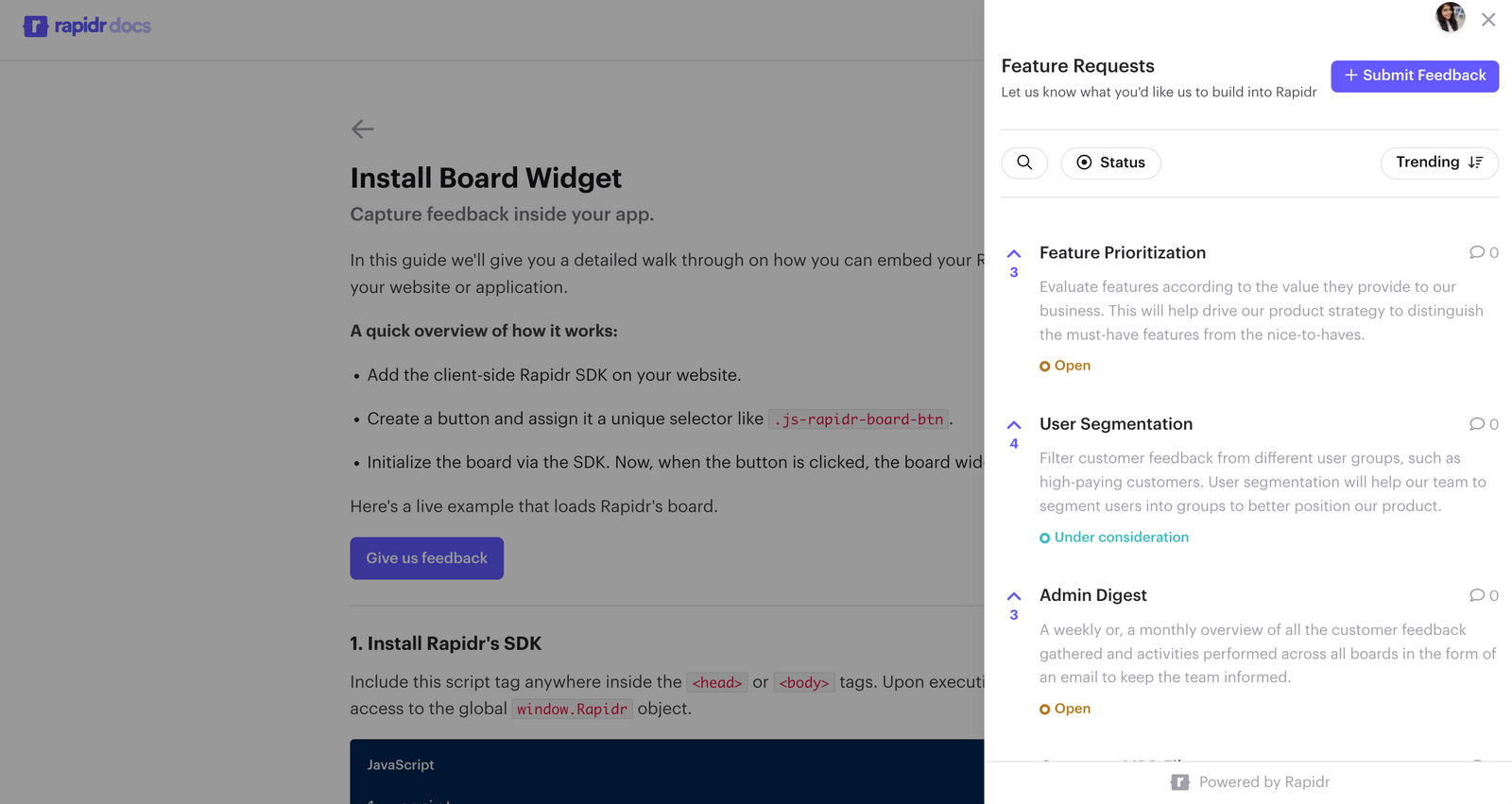
User Interviews
One-on-one user interviews offer an opportunity to get detailed and nuanced feedback. The interviewer can probe deeper into a user's experiences and opinions, and ask follow-up questions based on the user's responses.
Customer Feedback Tools
Customer feedback tools help businesses understand customers' thoughts about their products or services. With these feedback tools, one can gain insight into what customers think about the company's services and use that information to make positive changes to improve customer satisfaction.
Customers feel like they’re being heard when they give their opinion on a product or service, which creates loyalty and goodwill towards the company.
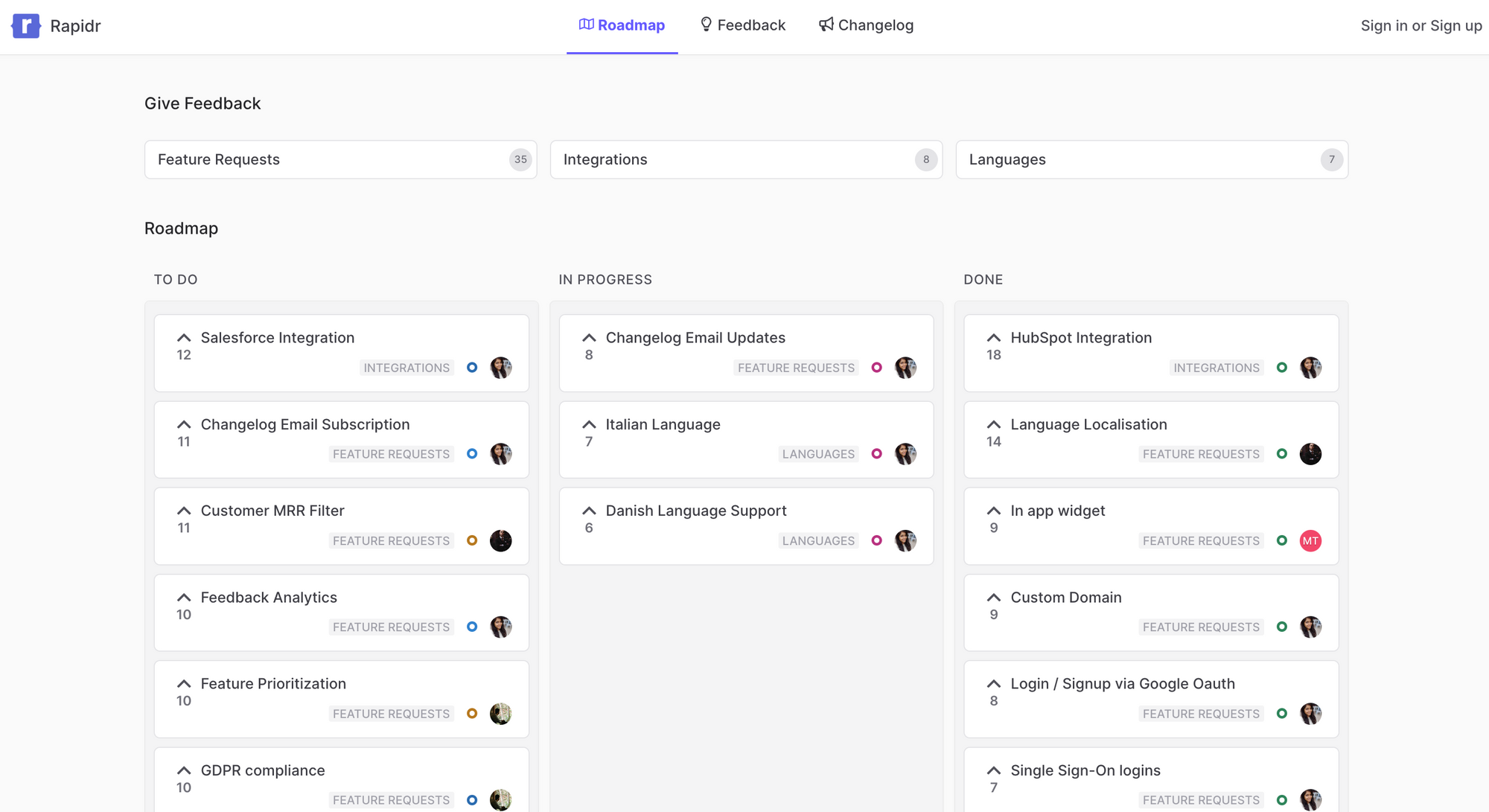
Feedback Forms
Feedback forms via Typeform with Zapier integration can be available on your website and within your app with Rapidr. They can be useful for capturing spontaneous feedback, but be aware that they might only represent the most vocal users, which may not be representative of all users.
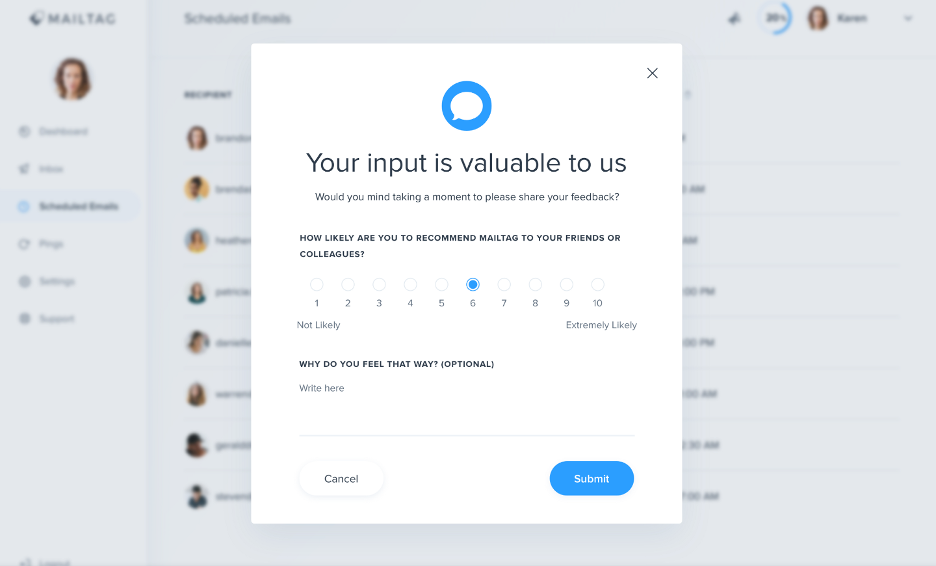
Slack & Intercom Feedback Channels
Track customer feedback in Slack using Rapidr's integration. Rapidr helps your customer success and product teams be more productive by capturing feedback directly anywhere from Slack without losing context.


Rapidr's deep Intercom Integration makes it easy for your product and customer success teams to track incoming feedback right on Intercom. Track customer feedback and feature requests while conversing with the customers in Intercom Inbox. Capture the votes of customers requesting feedback requests already present directly in Inbox to avoid duplication.
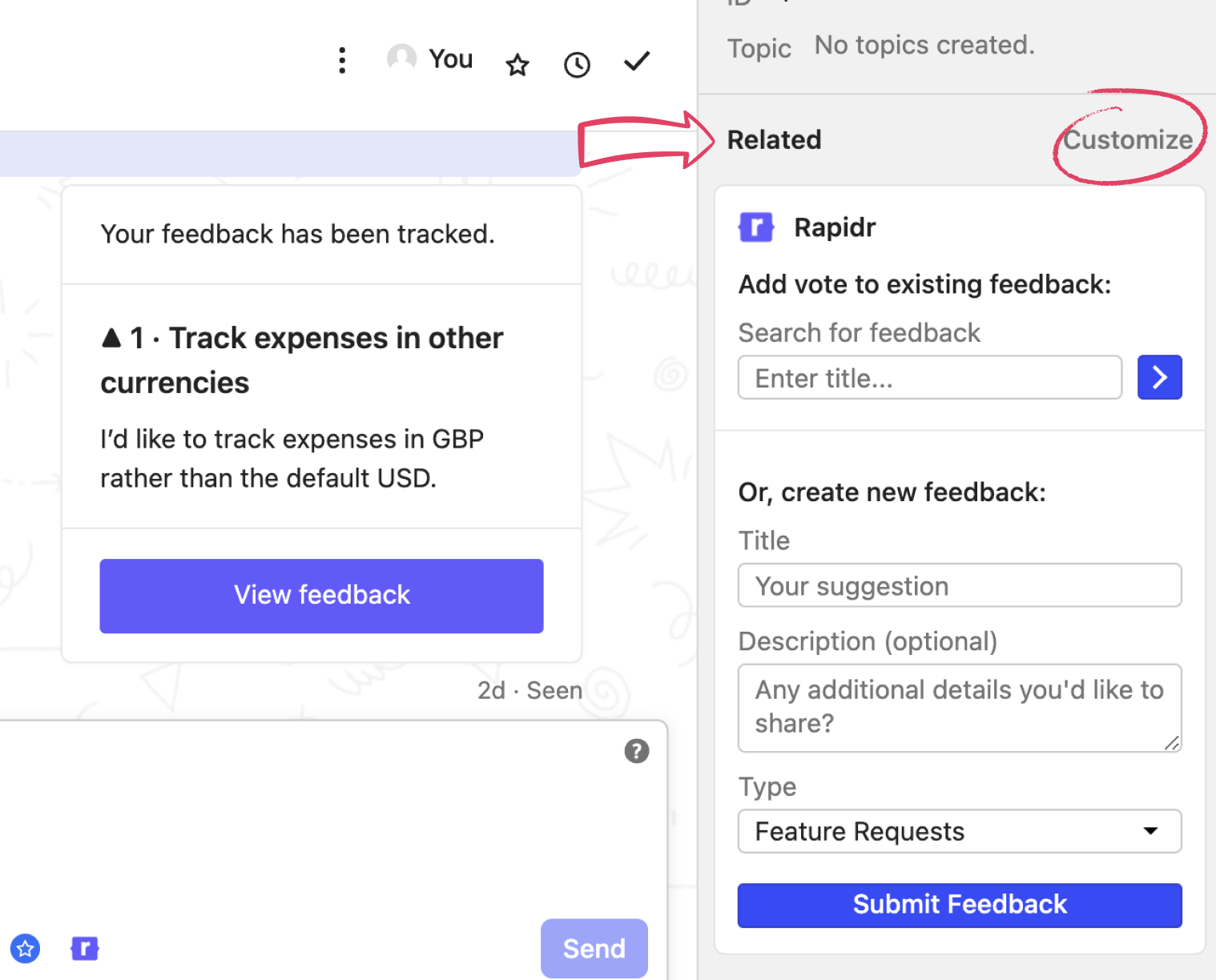
Community Feedback Forums
Community feedback forums allow customers to report bugs, request new features, discuss the benefits of existing features, and submit support tickets, and grievances, and positive feedback does the trick.
Customers can also engage with one another and gain insights there. It’s also a great way to close the feedback loop and fill the void between what the businesses offer and what their customers want.
If your company has a community forum or any kind of user focus group, this can be a great place to gather feedback. Users often share their experiences and suggestions here, and customer success teams can also use these platforms to ask for feedback directly.

In-app Feedback
In-app feedback is a system that allows users to provide feedback on their experience with the app while using it. It can be done by writing a review, rating the app, suggesting a new feature, or giving a thumbs up or down.
In-app feedback can help companies improve their product by collecting customer feedback and making changes based on their opinions.
Social Media & Online Reviews
Social media platforms and online review sites (like Twitter, G2, and Capterra) help gather unsolicited feedback. Users often express their honest opinions about a product or service on these platforms, which can provide valuable insights.
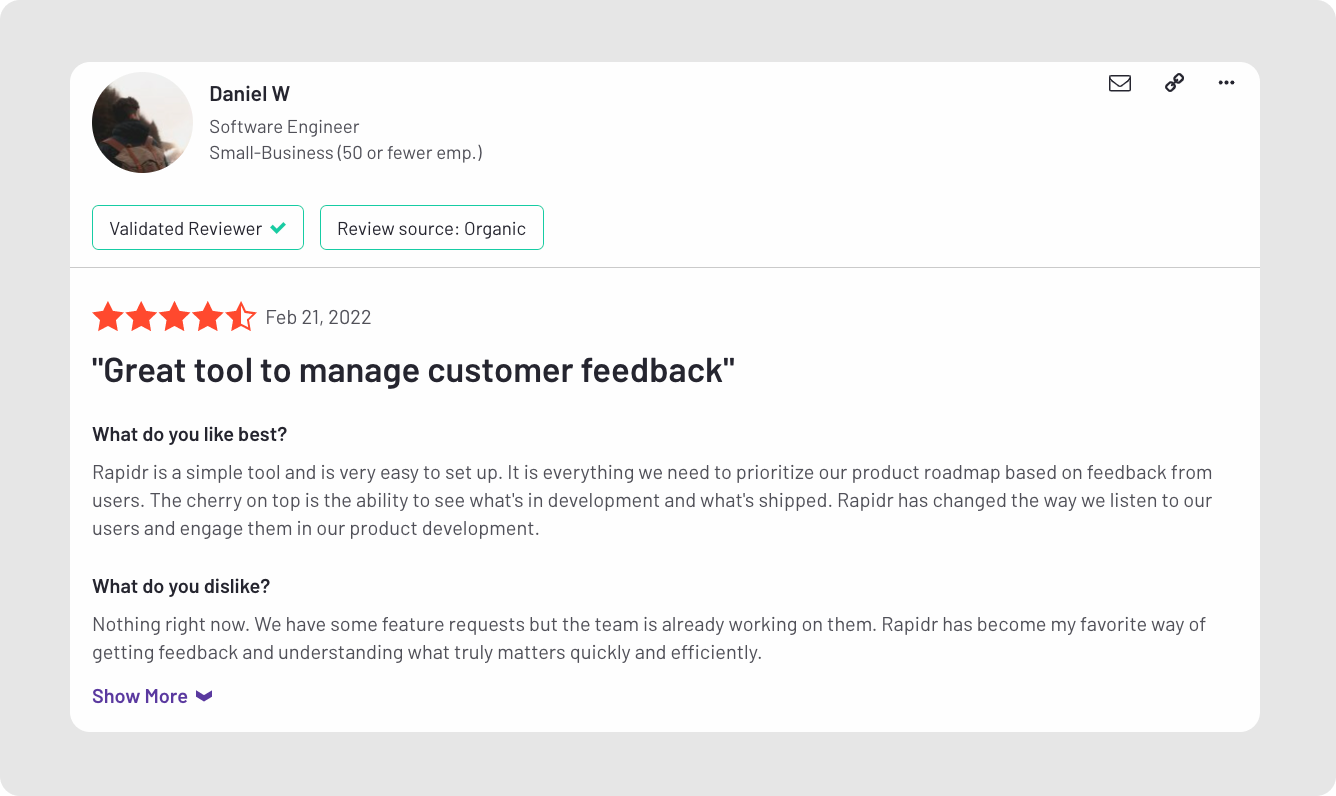
Remember, gathering feedback is only the first step. You also need to analyze this feedback, identify common themes or issues, and use this information to inform decision-making and drive improvements.
It's also important to close the loop with users - let them know that their feedback has been heard and tell them about any changes or improvements you've made as a result. This can help to build a stronger relationship with your users and encourage them to provide feedback in the future.
Role of customer success teams in customer feedback management
Customer success teams play a significant role in managing customer feedback, from collection to analysis and implementation. Their understanding of customer needs and their direct communication with customers make them ideally suited to this task. Here are some of the specific roles they play in customer feedback management:
Collecting Feedback: As the frontline of customer interaction, customer success teams have numerous opportunities to collect user feedback. This can be done during service calls, through website feedback buttons, follow-up emails, or using customer surveys.
Analyzing Feedback: After collecting feedback, customer success teams, along with product teams, can analyze this data to uncover patterns, trends, and issues. By interpreting this feedback, they can gain valuable insights into their target audience.
Identifying Areas of Improvement: Based on the analysis, customer success teams can identify areas where the product, service, or customer experience can be improved. This might include identifying product bugs, recognizing gaps in service, or spotting opportunities for product enhancements.

Define Product Strategy: Customer Success teams serve as the bridge between the customer and the organization, providing valuable insights to define product strategy.
- They identify areas of improvement or potential new features and, track customer usage and interactions with the product, understand where customers find value and where they experience challenges.
- They identify trends and patterns that can drive product enhancements and innovations.
- By monitoring customer health metrics and satisfaction scores, they help gauge how product changes affect customer satisfaction and loyalty.
- Customer Success teams ensure the customer's voice is integrated into the product strategy, aligning it better with market needs and expectations.
Product Roadmapping: Customer Success teams play a crucial role in the product roadmapping process, offering insights and information that can help guide decision-making and prioritization.
By incorporating the insights provided by the Customer Success team, companies can ensure their product roadmap is customer-centric, realistic, and focused on delivering value, thereby improving customer satisfaction and retention.
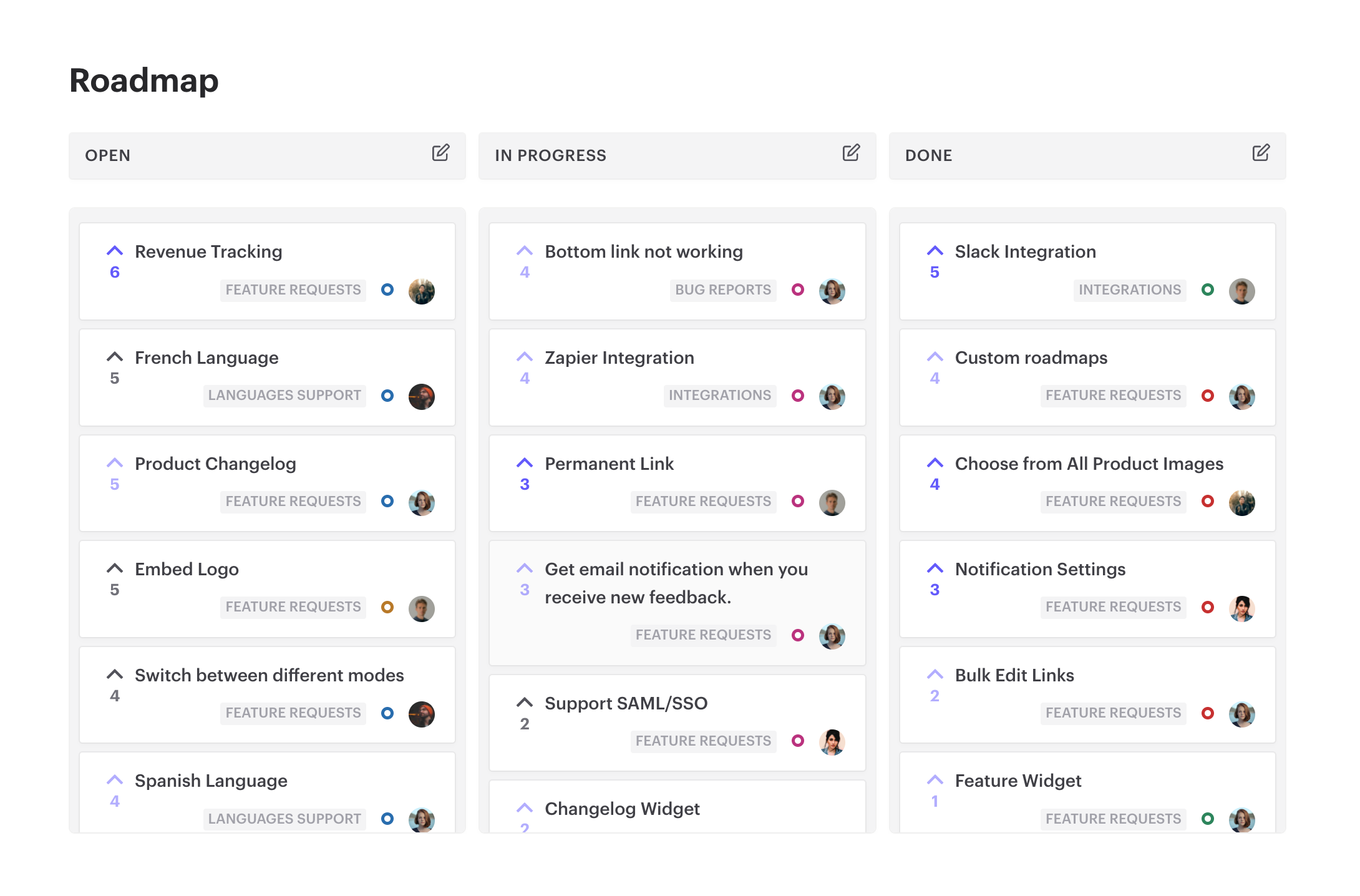
Communicating Feedback to Relevant Teams: Customer success teams act as the bridge between customers and other departments in the organization. They communicate customer feedback to the relevant teams, such as product development, marketing, or sales, ensuring that the feedback is used to drive improvements.
Acting on Feedback: In their direct interaction with customers, customer success teams can act on feedback immediately. This might involve resolving a problem, changing the status of feedback provided by the user, upvoting on behalf of a customer, answering a query, or providing guidance on how to use a product or service.
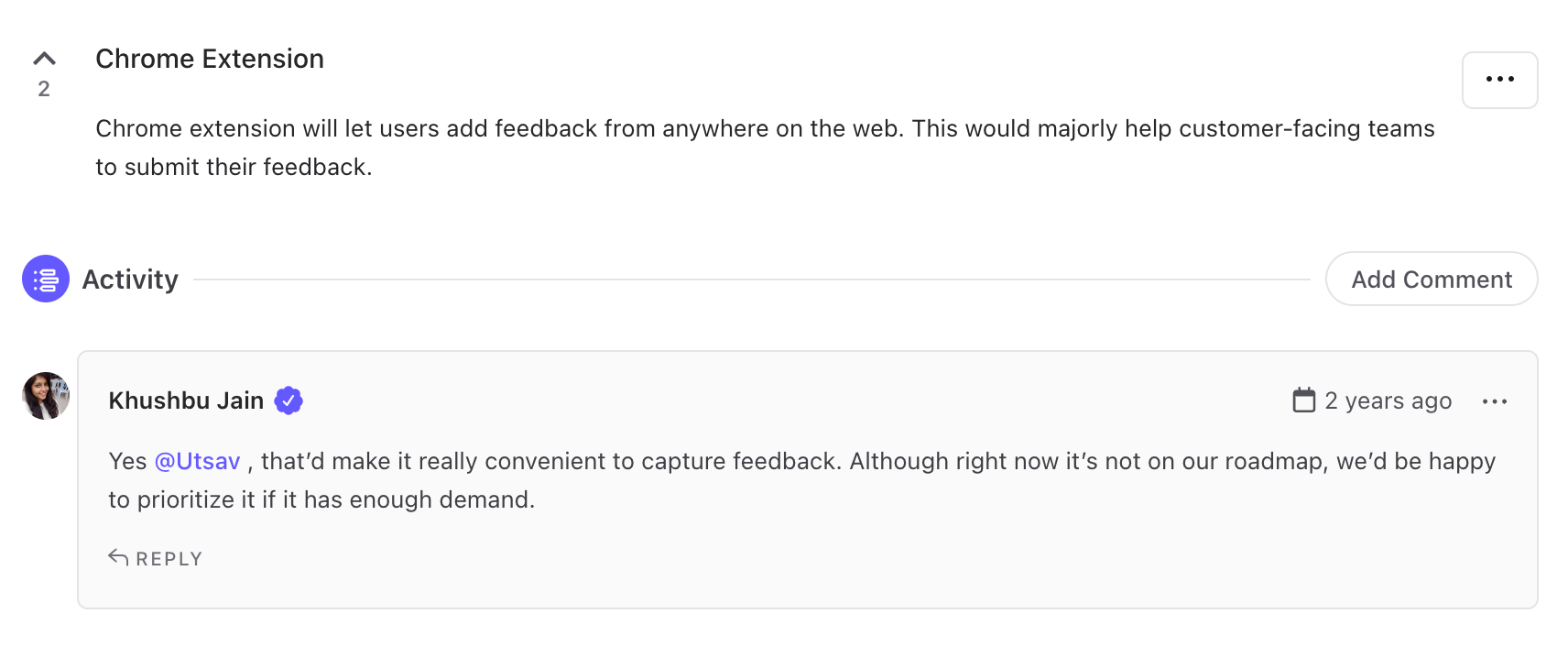
Tracking and Measuring: Customer success teams also track and measure the impact of changes made based on customer feedback. They monitor key metrics such as customer satisfaction scores, churn rates, and customer lifetime value to evaluate the effectiveness of their actions.
Closing the Feedback Loop: It's crucial for customer success teams to close the feedback loop by reaching back out to customers to inform them about the changes made based on their feedback. This not only shows customers that their opinions are valued, but it also strengthens the relationship and builds trust.
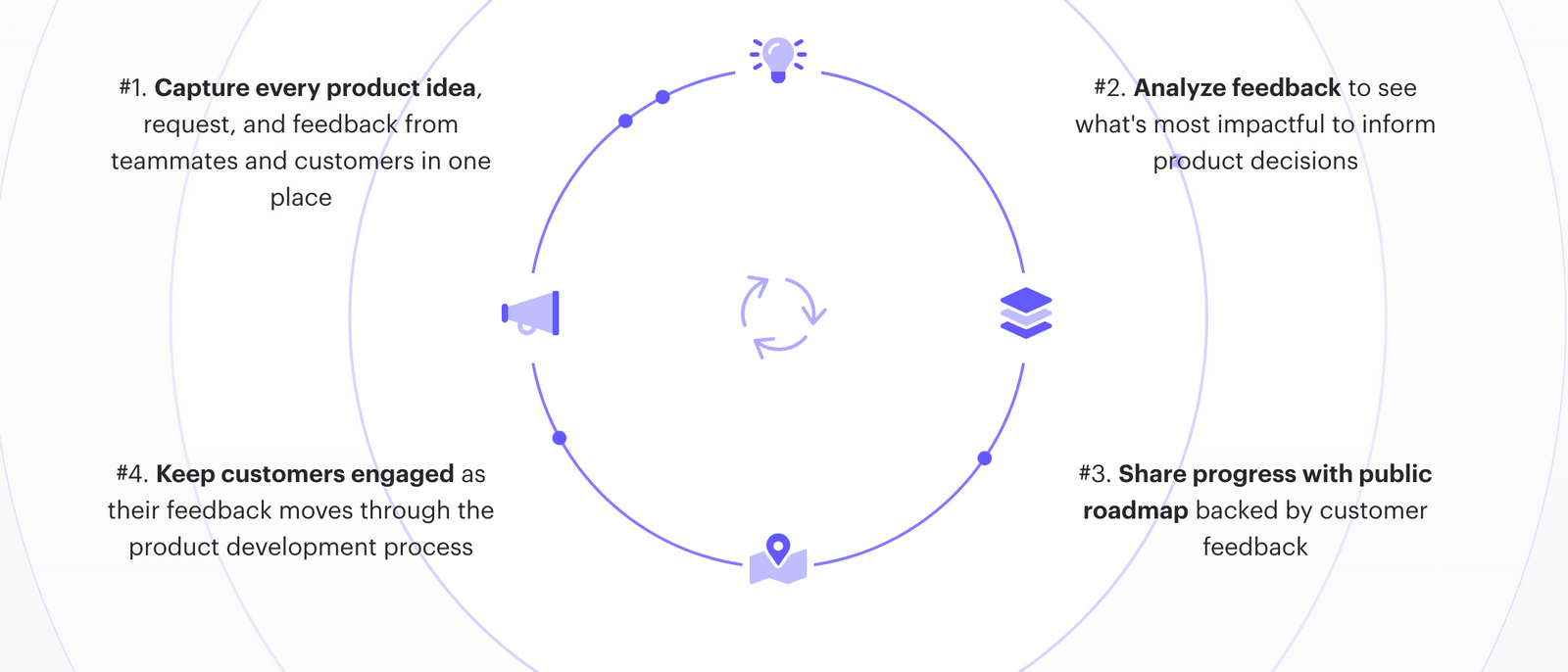
In conclusion, customer success teams are instrumental in managing customer feedback. They help collect, analyze, and act on feedback, playing a crucial role in driving improvements and enhancing customer satisfaction and success.
Enhance customer feedback management with customer success teams
In conclusion, the role of customer success in the customer feedback management process is fundamentally crucial. This is because customer success teams are at the forefront of interactions with users, serving as the organization's face and voice.
The role of the customer success team in this process is multifaceted; they gather feedback through numerous channels, engage in active dialogue with customers, conduct user interviews and surveys, and even analyze interactions and online reviews.
But perhaps most importantly, the customer success team bridges the gap between the customer and the rest of the organization. They humanize customer feedback, transforming it from abstract data into actionable insights to drive strategic decision-making and continual improvement.
Hence, the customer success team is not just a passive receptor of feedback but an active participant in its management and application, making them an invaluable component in any customer-centric organization.
With Rapidr, you can collect, analyze, and organize feedback and engage with customers as their feedback moves through the development process. Sign up and set up a complete customer feedback system to find and solve your customer pain points.
FAQs
What is customer feedback?
Customer feedback is the information, insights, and opinions customers experience with your product or services, including positive reactions and complaints.
Why is customer feedback important?
Customer feedback is essential for a variety of reasons:
- Customer feedback is valuable for developing enhancements or new offerings that better meet customer needs.
- Customer feedback provides data-driven insights for product development, marketing strategies, and business planning.
- Customer feedback strengthens customer relationships, builds trust, and increases customer engagement and loyalty.
- Customer feedback helps prevent customer churn and enhances the overall customer experience, leading to higher customer satisfaction.
- Customer feedback can reveal market trends and shifting customer needs or preferences.
Why include customer success teams in customer feedback management?
Customer feedback is invaluable for any business. It helps businesses understand their customers better and make informed decisions. However, managing customer feedback can be a tedious and time-consuming task.
That is why it is essential to include a Customer Success Team in managing customer feedback. Including customer success teams in customer feedback management is essential for several reasons:
- Direct Interaction with Customers: Customer success teams have a direct line of communication with customers. They can gather feedback during these interactions, understand customer issues better, and provide immediate solutions. This direct contact also allows them to ask follow-up questions to gain more detailed feedback.
- Understanding Customer Needs: As customer success teams work closely with customers, they develop a deep understanding of customer needs, expectations, and usage patterns. This knowledge can be invaluable when interpreting customer feedback and understanding its context.
- Timely Problem Resolution: Customer success teams can quickly act on feedback, promptly addressing customer issues. This timely response can lead to increased customer satisfaction and lower churn rates.
- Feedback Communication: Customer success teams can effectively communicate customer feedback to other departments, such as product development, marketing, and sales, ensuring the feedback is understood and acted upon across the organization.
- Building Trust with Customers: When customers see that their feedback is taken seriously, it builds trust and improves the relationship with the company. As customer success teams often communicate the actions taken in response to feedback, they play a critical role in building this trust.
- Closing the Feedback Loop: Customer success teams are essential in closing the feedback loop. They inform customers about the changes made based on their feedback, showing them their input is valued and impactful.
Which teams are involved in the customer feedback process?
Effective customer feedback management requires all customer-facing teams to collaborate to ensure that insights gained from feedback are utilized across the organization, ultimately leading to improved customer satisfaction and business growth.
Apart from customer service teams, these are the customer-facing teams collecting user feedback:
- Product Management Teams: PMs use customer feedback to guide product development, prioritizing features and improvements based on customer needs and experiences.
- Customer Support Teams: Customer support is customers' first point of contact when they have feedback or issues. They interact directly with customers, address their concerns, and gather feedback on their experiences.
- Marketing Teams: Marketing teams collaborate with product managers to analyze feedback to understand customer preferences and satisfaction, which can inform marketing strategies, messaging, and campaigns.
- Sales Teams: Sales teams can glean insights from feedback to understand customer needs better, optimize sales strategies, and improve customer relationships.
Which product management tools do customer success teams use to collect and manage user feedback?
In summary, customer success teams are vital in customer feedback management due to their close relationship with customers, their understanding of customer needs, and their ability to act on and communicate feedback. By involving customer success teams in feedback management, companies can ensure a customer-centric approach to problem resolution and product improvement.
Customer success teams use various product management tools to collect and manage user feedback. Some commonly used tools include:
- Customer Feedback Software: There are dedicated customer feedback tools like Rapidr, and UserVoice that allow customer success teams to gather, organize, and analyze feedback from users. These tools often include features such as feedback submission forms, voting systems, commenting capabilities, and analytics to help prioritize and track user feedback.
- Customer Relationship Management (CRM) Systems: CRM systems like Salesforce, HubSpot, or Zoho CRM are commonly used by customer success teams.
- Helpdesk Software: Zendesk, Freshdesk, or Intercom includes features that enable customer success teams to manage customer support tickets and inquiries.
- Project Management Tools: Jira, Trello, or Asana are commonly used by customer success teams to manage tasks and projects.
- Collaboration and Communication Tools: Tools like Slack, Microsoft Teams, or Google Workspace facilitate team communication and collaboration.
- Survey and Feedback Tools: Customer success teams utilize survey and feedback tools such as SurveyMonkey, Typeform, or Google Forms to collect structured feedback from users.

